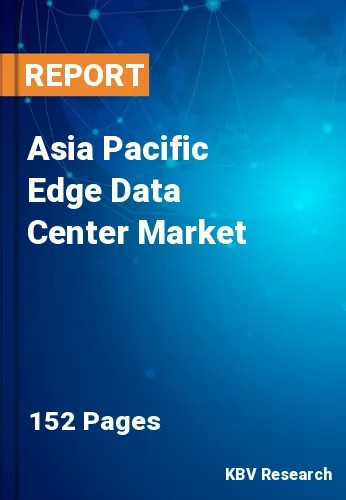The Asia Pacific Edge Data Center Market would witness market growth of 20.7% CAGR during the forecast period (2021-2027).
The growing use of digital services is altering the way data centers are deployed. It takes longer to supply digital services to clients as the distance from the data center grows. When compared to storing data in a centralized warehouse, creating data centers closer to the center of the application allows for complete control of data processing and storage at the network's edge. Edge Data Center Market growth is estimated to be fueled by demand for lowered network traffic, cheap operational costs, real-time data analysis, and increased application performance. Additionally, the increasing mobile data traffic around the world is a key factor driving the growth of the Edge Data Center Market. As the number of smartphones along with IoT devices grows, so does the amount of mobile data traffic. As a result, the demand for edge data centers is becoming more critical.
Sensitive data is handled on-site in Edge systems, with only privacy-compliant data being transferred to the cloud to be analyzed. Even when network connectivity is restricted or inconsistent, edge computing assures that applications are not disrupted. This is especially relevant for applications that are deployed in remote places with intermittent access. The monthly cost of power used for cooling in large data centers can surpass the cost of the electricity utilized for processing. In theory, controlling the climate in numerous smaller data center areas may cost a company less than controlling the climate in a huge data center.
Due to growing investments in the advancement of digital transformation and cloud projects in countries such as Japan, India, and especially China, APAC would experience substantial development. According to a Market and Ecosystem Report for Edge Computing, APAC will have the greatest edge computing equipment penetration 1 of 187 MW in 2020, which is the highest across regions. The micro mobile data center market in the region is also developing due to rising demand for hyper-converged and hyper-scale infrastructure, as well as an increase in the number of internet-connected people.
Leading organizations such as Amazon Web Services, Google, and Microsoft are significantly investing in APAC and constructing data centers there. These significant expenditures are assisting in the development of the APAC edge data center market.
The China market dominated the Asia Pacific Edge Data Center Market by Country in 2020, and would continue to be a dominant market till 2027; thereby, achieving a market value of $1,758.4 million by 2027. The Japan market is estimated to witness a CAGR of 20% during (2021 - 2027). Additionally, The India market would showcase a CAGR of 21.5% during (2021 - 2027).
Based on Component, the market is segmented into Solution (Networking Equipments, DCIM & Analytics, Power, Cooling, and Others) and Services (Integration & Implementation, Consulting, and Managed). Based on Facility Size, the market is segmented into Large and Small & Medium. Based on Vertical, the market is segmented into IT & Telecom, BFSI, Retail & E-commerce, Government, Healthcare & Life Sciences, Manufacturing, Gaming & Entertainment, Automotive, and Others. Based on countries, the market is segmented into China, Japan, India, South Korea, Singapore, Malaysia, and Rest of Asia Pacific.
Free Valuable Insights: The Worldwide Edge Data Center Market is Projected to reach USD 21.4 Billion by 2027, at a CAGR of 19.9%
The market research report covers the analysis of key stake holders of the market. Key companies profiled in the report include Dell Technologies, Inc., Eaton Corporation PLC, NVIDIA Corporation, Schneider Electric SE, Hewlett Packard Enterprise Company, Huawei Technologies Co., Ltd., IBM Corporation, Vertiv Holdings Co., Fujitsu Limited, and Equinix, Inc.
By Component
By Facility Size
By Vertical
By Country
Our team of dedicated experts can provide you with attractive expansion opportunities for your business.

